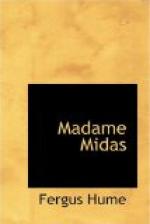Q. You say the bottle was half empty?
A. Rather more than that: three-quarters empty.
Q. Miss Marchurst told M. Vandeloup she had poured half the contents of one bottle into the other. Would not this account for the bottle being three-quarters empty?
A. Possibly; but if the first bottle was full, it is probable she would halve the poison exactly; so if it had been untouched, it ought to be half full.
Q. Then you think some of the contents of this bottle were used?
A. That is my opinion.
Vandeloup was recalled, and deposed that the bottle Kitty took from his desk was quite full; and moreover, when the other bottle which had been found in her room, was shown to him, he declared that it was as nearly as possible the same size as the missing bottle. So the inference drawn from this was that the bottle produced being three-quarters empty, some of the poison had been used.
The question now arose that as the guilt of Miss Marchurst seemed so certain, how was it that Selina Sprotts was poisoned instead of her mistress; but this was settled by Madame Midas, who being recalled, deposed that Kitty did not know Selina slept with her on that night, and the curtains being drawn, could not possibly tell two people were in the bed.
This was all the evidence obtainable, and the coroner now proceeded to sum up.
The case, he said, was a most remarkable one, and it would be necessary for the jury to consider very gravely all the evidence laid before them in order to arrive at a proper conclusion before giving their verdict. In the first place, it had been clearly proved by the Government analyst that the deceased had died from effects of conia, which was, as they had been told, the alkaloid of hemlock, a well-known hedge plant which grows abundantly in most parts of Great Britain. According to the evidence of Dr Chinston, the deceased had died from serous apoplexy, and from all the post-mortem appearances this was the case. But they must remember that it was almost impossible to detect certain vegetable poisons, such as aconite and atropia, without minute chemical analysis. They would remember a case which startled London some years ago, in which the poisoner had poisoned his brother-in-law by means of aconite, and it taxed all the ingenuity and cleverness of experts to find the traces of poison in the stomach of the deceased. In this case, however, thanks to Dr Gollipeck, who had seen the similarity of the symptoms between the post-mortem appearance of the stomach of Adele Blondet and the present case, the usual tests for conia were applied, and as they had been told by the Government analyst, the result was conia was found. So they could be quite certain that the deceased had died of poison—that poison being conia. The next thing for them to consider was how the poison was administered. According to the evidence of Miss Marchurst, some unknown person had been standing




